This post explains safe bicycle lane positioning and riding in traffic. With a bit of caution, bicycle can be ridden on public roads quite safely, even in heavy traffic. Post that explains basic things about human attention and noticing bicycles in traffic is here: Sorry, I didn’t see you – cyclist traffic safety.
Articles in the series:
- Sorry, I didn’t see you – cyclist traffic safety
how the human eye works and how to get drivers’ attention - Bicycle lane positioning and riding in traffic
how to avoid drivers’ “blind spots” - Bicycle lights, and the difference between “visible” and “noticeable”
why they are important, and how to properly “light” a bicycle - Typical risky situations when cycling in traffic
9 scenarios you should be prepared for in advance
All the advice in this post should be taken at one’s own risk assessment and comfort level. It is more a guideline, not carved in stone. Particular traffic situations one faces vary vastly (by traffic, road conditions and driver’s habits), so each should decide for themselves what the best thing to do is. Still, some guidelines and ideas given in this text could be useful to cyclists in traffic.
First thing explained are the differences between a bicycle and other vehicles. Then it will say a few words about relative speed, that is the speed difference between a bicycle and other (motor) vehicles. Term of blind spots – areas around vehicles invisible to the vehicles’ drivers is also explained. Finally, a few words about how lane positioning affects visibility. A separate post explains several common risky traffic situations and how to avoid them.
Term “bicycle” will refer to a cyclist riding a bicycle of course. Terms “car”, “motorcycle”, “bus”, “vehicle” etc will refer to the vehicle and the driver operating it.
1. Bicycle is not a car
Nor a motorcycle. Obviously. 🙂 Often, when discussing use of bicycles in traffic, one can hear things like: “when using the road, the same rules apply for bicycles as for cars. Bicycles aren’t exception and should behave like cars…” Well, not all the laws are the same (try riding a bicycle on a motorway without getting a fine), nor are the vehicles similar. What are the differences between a bicycle and a car and how to they affect safety and behaviour in traffic?
- Bicycle is slower. By a lot. This means it often significantly slows down the cars if they can’t overtake it. Except on downhills, bicycles hardly ever reach great speeds.
- Bicycle is a lot narrower than a car, which allows it to move to the left, or right part of the lane. Driver, sitting behind a wheel on the left side of the car, will have problem seeing what is on the right side of a vehicle that is in front of him/her. For a cyclist this is not a problem. They will both have a good view of the left side, but for a cyclist to do this, it will take re-positioning within the lane. In case of a traffic stuck in a jam, a cyclist can easily filter between the stationary vehicles (with caution).
- Bicycle is less stable. It will swerve (more or less, depending on road conditions and rider’s skill), it will lean when turning. Slipping of the bicycle’s front wheel often leads to a fall.
- Bicycle is smaller, less visible and harder to spot and notice.
- Cyclist usually sits higher than a driver and can observe the surroundings over the cars around them.
- Cyclist is a lot less protected. Without a metal cage around them, cyclists are a lot more vulnerable. Simple opening of car doors when the cyclist is passing close by can lead to grievous injury or worse.
Serbian traffic law parts related to bicycles.
2. Relative speed and lane positioning according to it
When riding on a road, pay attention to usual speed of other vehicles. The faster they are going compared to the bicycle, the more it should move to the right side of the road – since there is less time for vehicles coming from behind to spot the bicycle and it slows them down more if they can’t overtake it. Of course, don’t move too much to the right if it isn’t safe – potholes, doors of parked cars etc.
When riding at the speed of other vehicles, bicycle can stay in the middle of the lane – since then bicycle is traffic as well.
When riding faster than the traffic, if safe, bicycle can overtake other vehicles – just like any other vehicle does. Passing it on the left hand side, of course.
This is just a general rule, with a lot of exceptions in particular situations. Some of the typical scenarios will be explained in the rest of this post.
3. Vehicles’ blind spots
There are areas around vehicles where drivers simply can’t see anything. When a cyclist is in a blind spot, they are literally invisible for the driver.
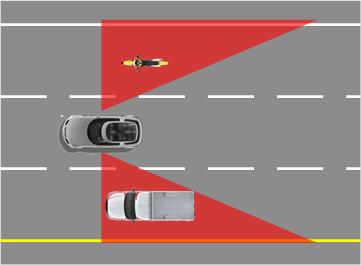
Red zone is usually invisible to drivers.
Depending on particular driver’s skill, caution, and knowledge of rear view mirror adjustment, these blind zones can be smaller, or a lot bigger.
Unlike blind spots, zones of good visibility are marked green in the picture below:
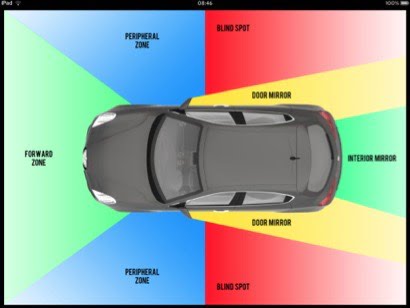
Blue: peripheral vision area. Some drivers are oblivious to it, but most can spot movement at least (if a cyclist is moving relative to the car, changing speed and angle, not going parallel to the car, they have more chance of being seen there).
Yellow: side rear view mirrors. Many people don’t adjust them correctly, some never use them.
Red: blind spots. If they don’t hear a crash, or aren’t extremely cautious, drivers will not turn their heads and check whether someone is in those zones.
With buses and lorries it gets even worse:
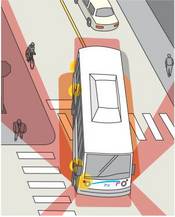
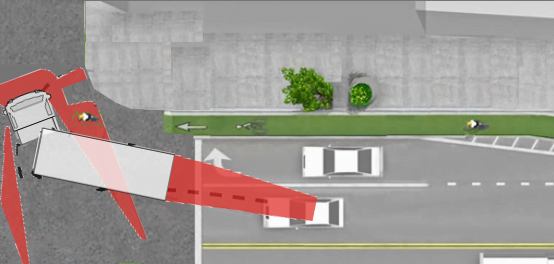
Why is it important to know (about) these blind spots? So that one can stay bloody out of them, of course! 🙂
When approaching a vehicle in order to pass it by, go around it, or even overtake it, one must be aware: when a bicycle is in a blind spot, it is invisible to the driver. So before entering a blind spot, use bicycles relatively low speed and the time available to look inside the cabin: where is the driver looking, how are their hands placed on the steering wheel, are the front wheels of the vehicle turning to one side perhaps? Check the situation around the vehicle. Could the driver be looking for a parking spot, to overtake another vehicle, or make a u-turn? If anything suspicious is noticed, it is a good idea to stop at a safe distance, before entering a blind spot.
When in a blind spot – move out of it as soon and as quickly as possible (and safe). Since a bicycle is considerably slower than motor vehicles, it is usually the best and safest option to slow down, or turn (if turning is safe and required).
It happens that a driver starts overtaking a cyclist, then, because of a congestion in traffic, continues driving slower, parallel to the cyclist, leaving the cyclist in the blind spot. In a matter of a few seconds, drivers can often forget about the previous overtake and the bicycle in their blind spot. The safest option (besides knocking on a window which will startle most drivers 🙂 ) is to slow down, letting the vehicle move in front, to a safe distance.
4. Lane positioning and how it affects visibility
4.1. Lane postitions explained
One traffic lane, from a bicycle’s perspective, can be divided into three major parts: A left car wheel track, B middle of the lane, C right car wheel track. In addition to these, there are extreme right (R) and left (L) position – hugging the ends of the lane.
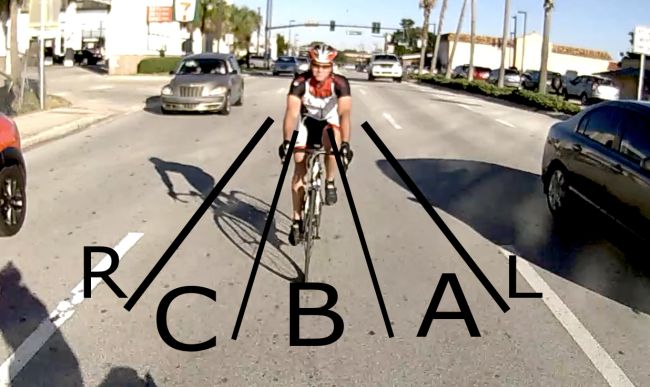
A – track of left car wheels
B – middle of the road
C – track of right car wheels
L – all the way to the left, hugging the lane splitting line
R – all the way to the right side of the road, hugging the kerb
4.2. How lane positioning affects visibility
Most conventional advice (and some regulations) suggests that cyclist should stick to the right most part of the lane – up to 1 meter from the kerb. This is fine usually and for most situations – but not always. How does lane positioning affect visibility?
Generally speaking, the more a bicycle is to the right hand side of the road (C, or R lane position), the less it is visible to vehicles coming from the opposite direction – especially if there’s some traffic in front of the bicycle in the same lane. The further it is to the left, the less it is visible to the vehicles pulling in from the right, if there is some traffic in front of it, if not, then the more it is to the left, the more visible it is. Middle of the lane is equally good (and bad 🙂 ) in those terms, but it makes it harder for the cyclist to see what’s in front of the vehicles in front of the cyclist.
So ideal lane position depends on current traffic situation – visibility, relative speed, road configuration and so on. Following few pictures will explain it better:
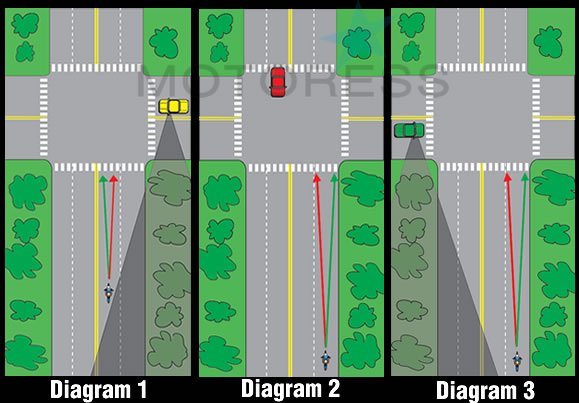
Depending on the traffic, different lane positions offer best visibility.
When approaching an intersection, it is often a good idea to catch drivers’ attention by moving from one side of the lane to the other (check over the shoulder if that’s safe, of course, not to run into another approaching vehicle).
Picture below shows a situation when moving to the right is a good choice. Simply – try to get eye contact with oncoming vehicle drivers as soon as possible. Moving left would “hide” the bike behind the red car.
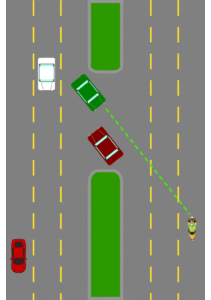
Next picture shows a car pulling in from the right, with a big lorry blocking the view. Staying further behind the lorry and to the right is a good choice.
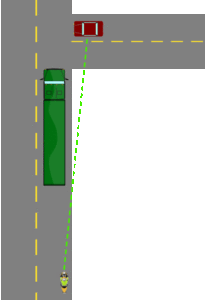
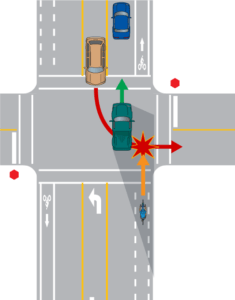
Car in front is blocking the view of the oncoming car turning left.
On the other hand, when there are no vehicles in front of the cyclist, better visibility to drivers is achieved by using the middle of the lane – since that is where the drivers are used to expect and look for oncoming vehicles.
As can be deduced from these pictures, it is the best policy to scan the situation around and adjust riding accordingly. There is no rule that can be given in advance, since situations vary so much. As a rule of thumb, always consider these questions:
- Can the drivers see me?
- Do they have enough time to react accordingly?
- Where am I most likely to be seen, noticed?
- Can I, without sacrificing visibility and safety, move the bicycle so I don’t obstruct and slow down other vehicles’ traffic?
A few more things to consider in corners and up/down hills:
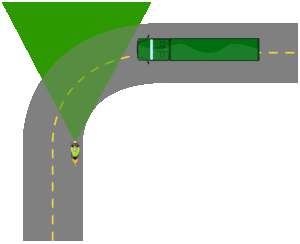
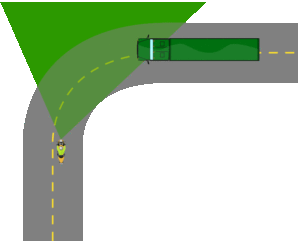
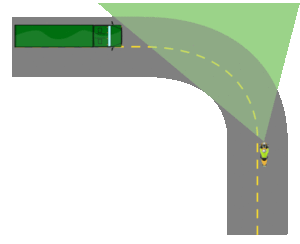
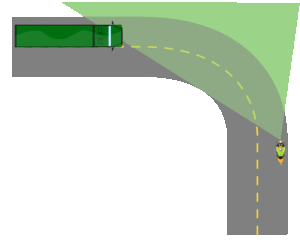
When reaching a hilltop, or a bridge top, always move as far to the right as possible – you never know what’s on the other side. Perhaps something like in the picture below:
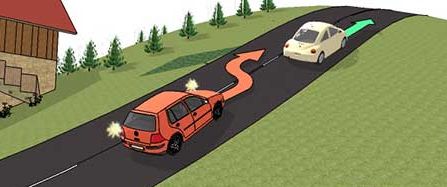
4.3. “Taking” the lane
Somewhat controversial topic: is it OK to ride in the middle of the lane, practically taking the whole lane, as if a bicycle were a car. Of course, this also depends on the current situation. But it is good to know that taking the lane is also an option, sometimes even the best one. This is explained in detail in a separate post, about risky traffic situations. Until having read that post, just one picture for consideration:
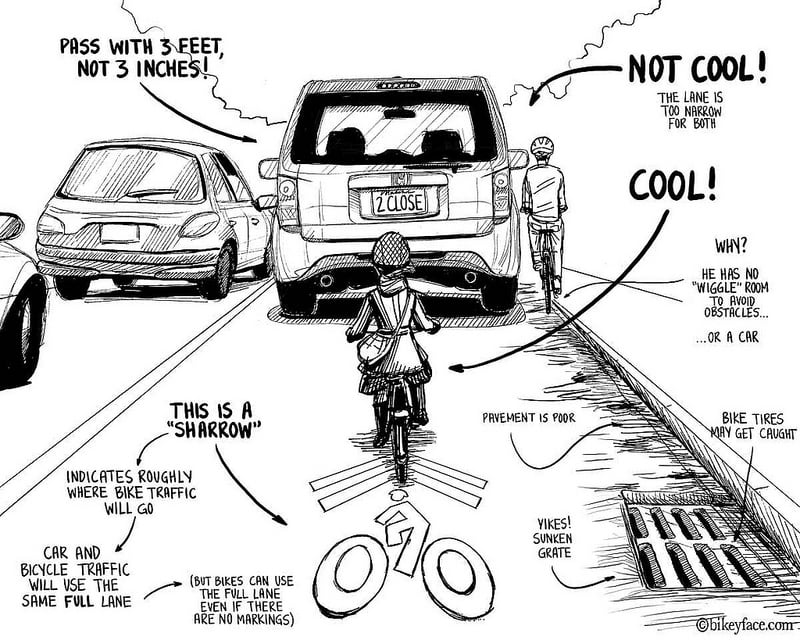
A more “philosophical” view on this topic is given in the post: Safe bicycle overtaking distance.
5. Final notes
Drivers are people just like all others. No better, or worse. Bicycle is a lot less visible and a lot slower than a car. That should be held in mind. Watch out for yourself, but don’t take anything personal. If, to a driver you had taken the whole lane in front moments ago, you wave with your arm to pass you, moving to the side of the road at the first safe/convenient stretch of road, they will have easier time understanding your side of the story and perhaps be more tolerant.
Traffic is a communication. Communicate with other drivers. Look for eye contact, head movement, use hand signals. Have patience and understanding. In case of a conflict, don’t escalate it.

Just smile and wave. They often remain confused and silent, in thought. 🙂
In the end, a few tips that can usually be taken as a rule of thumb:
- Always be predictable – drivers should know what you’re about to do, no sudden, unexpected manoeuvres.
- If in doubt: slow down, move off the road, stop. Mistakes in traffic are more costly than a few lost minutes.
- Just like driving any other vehicle in traffic: be careful, calm, but confident.
- Try to anticipate other people’s mistakes, and position yourself so that when (if) they happen, there’s no accident. Always try to read what the others will do.
Post that explains typical risky situations that happen in traffic and how to avoid an accident:
Typical risky situations for cyclist in traffic
